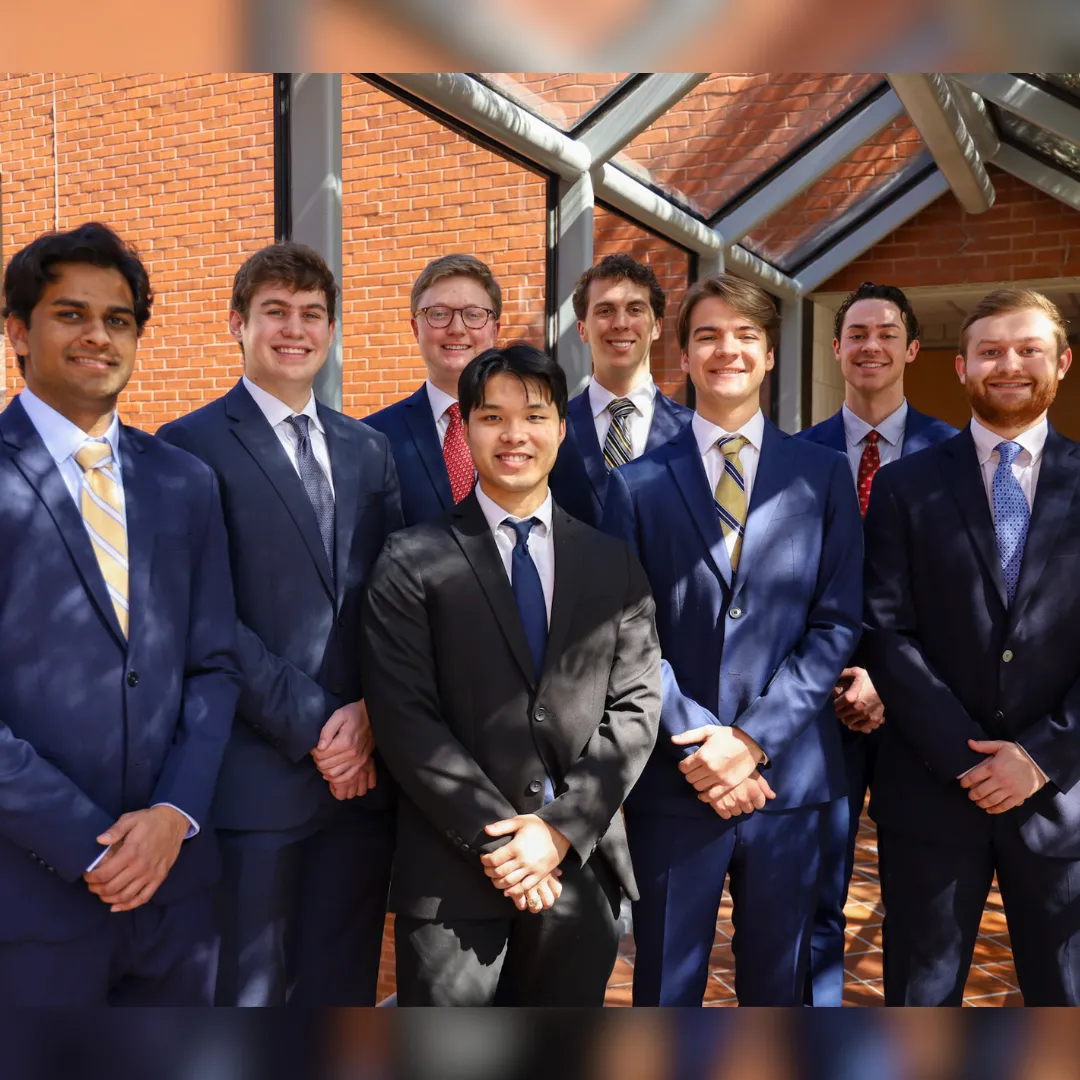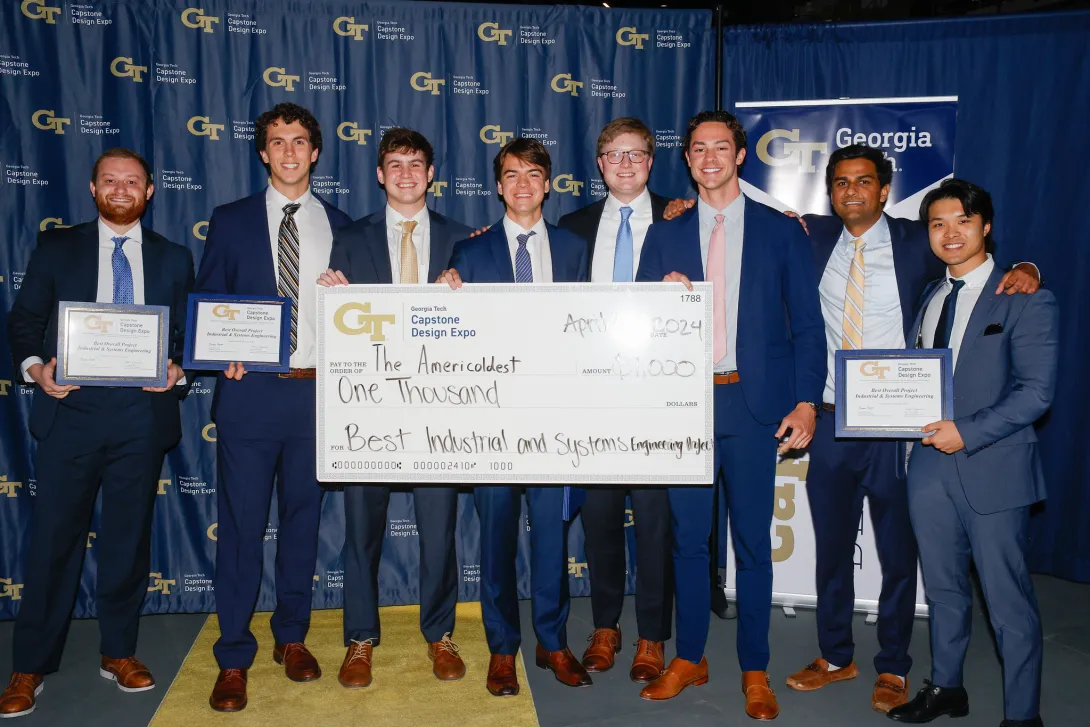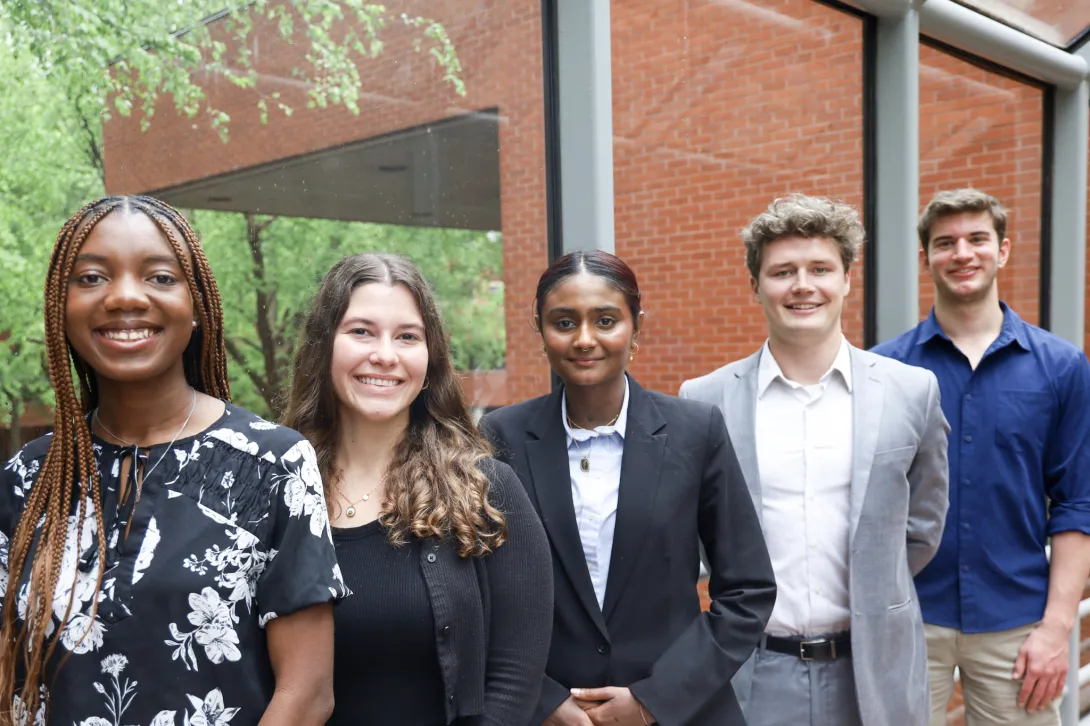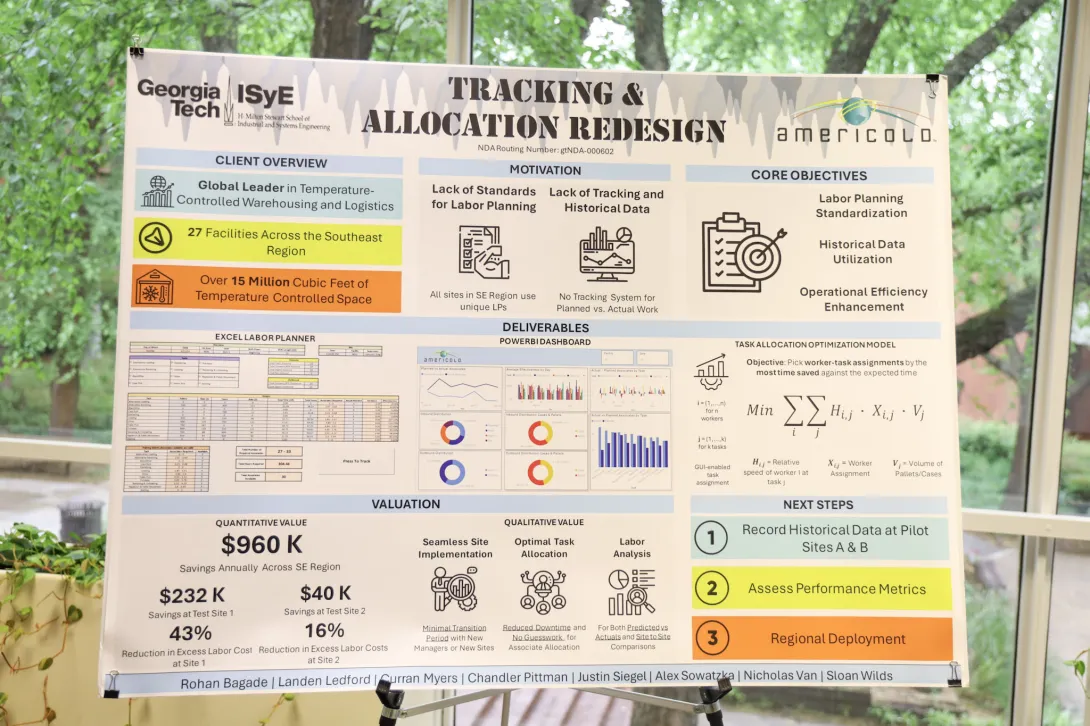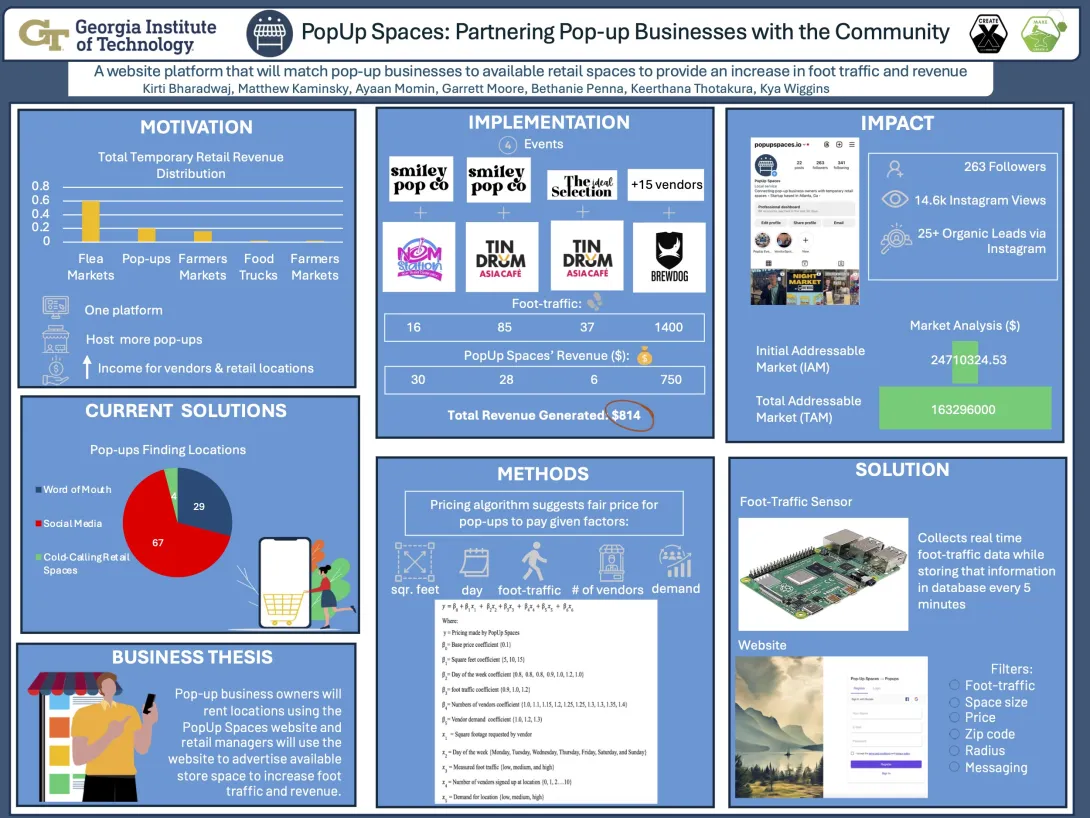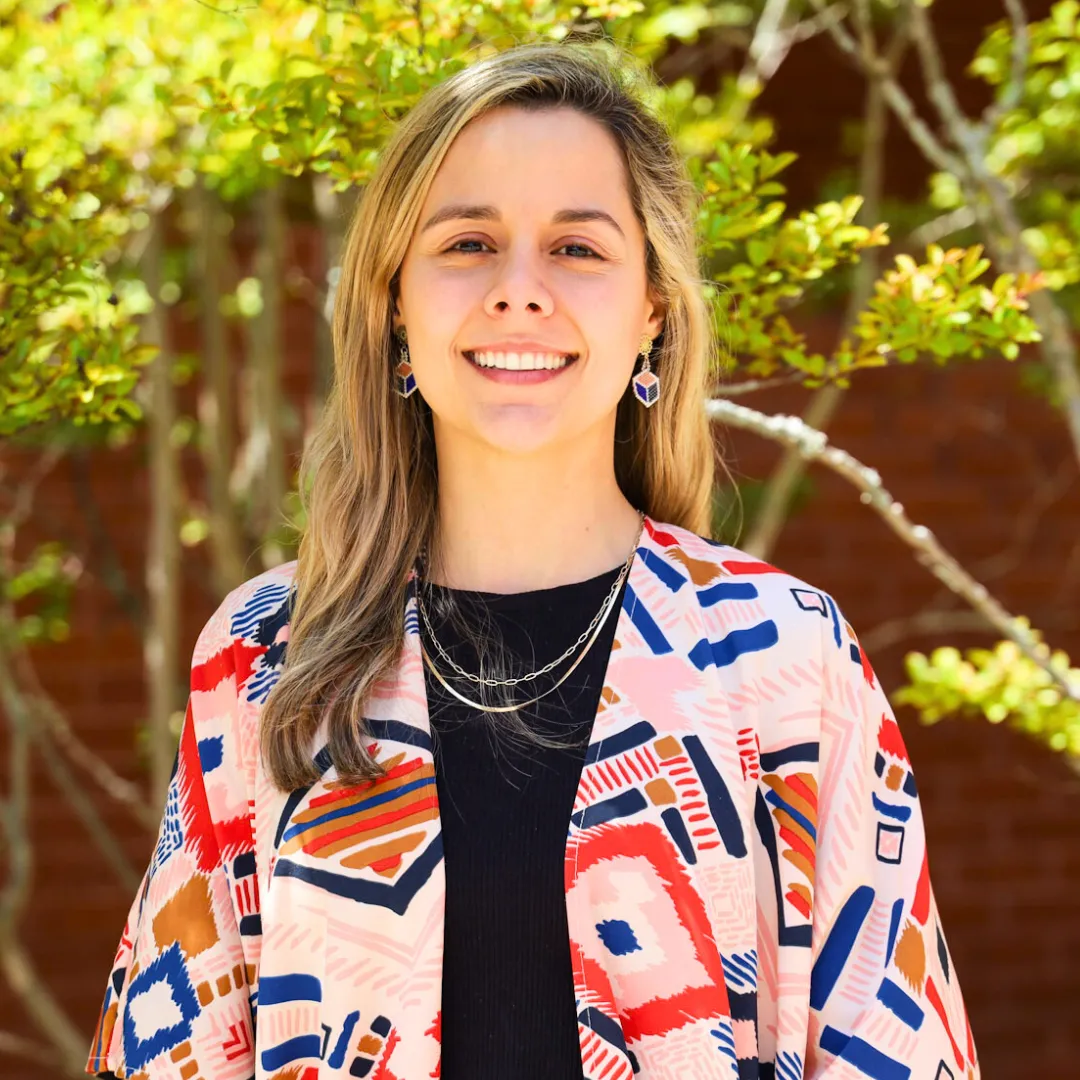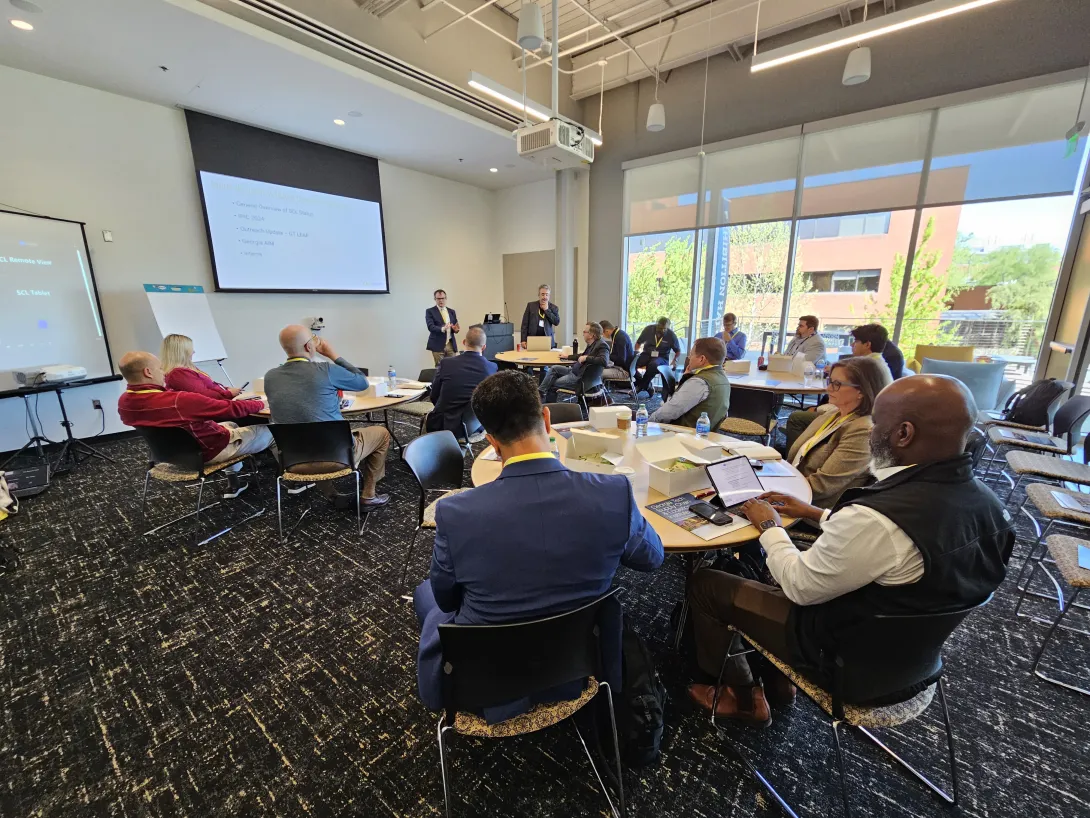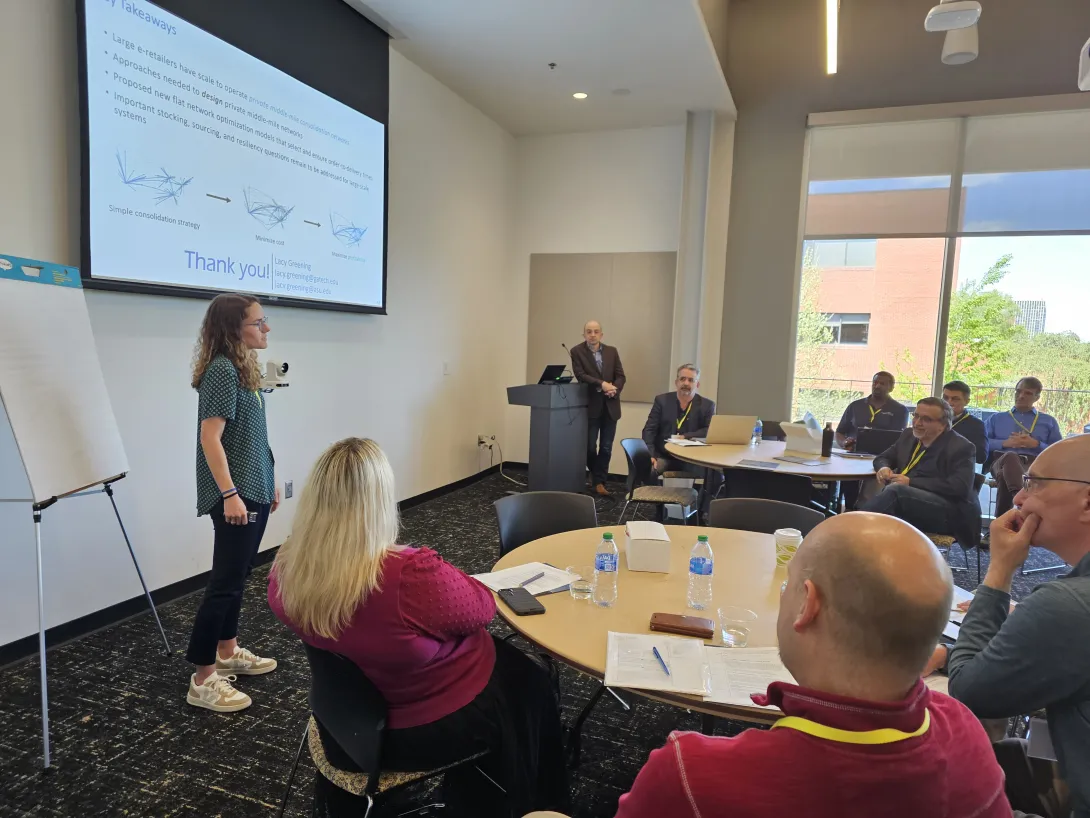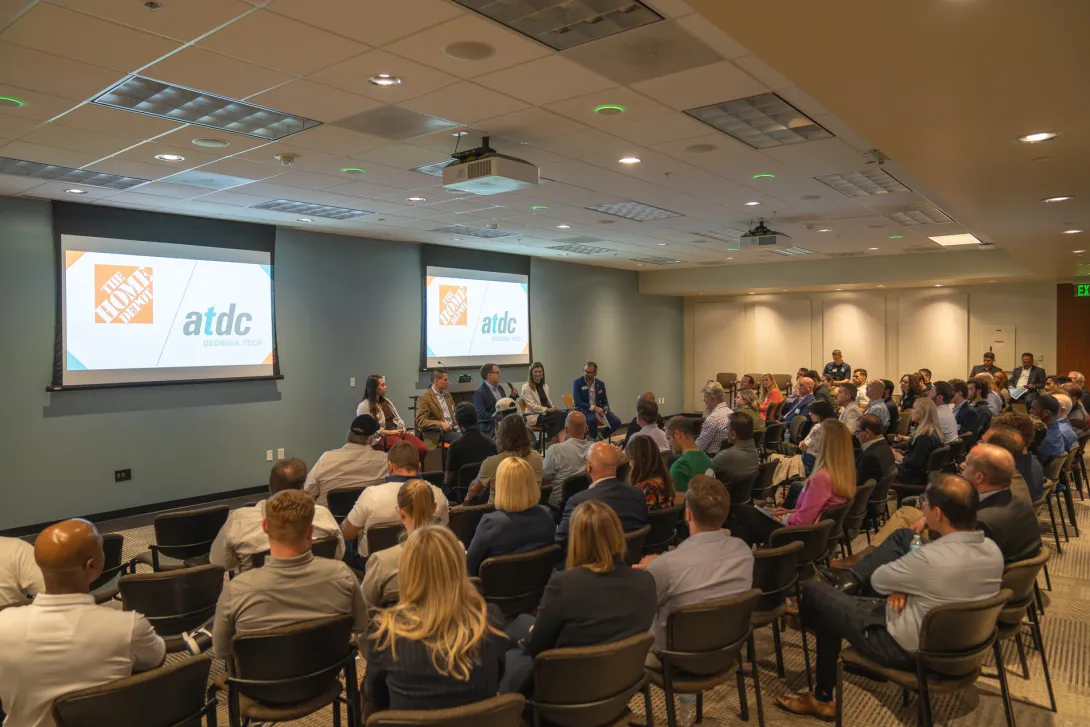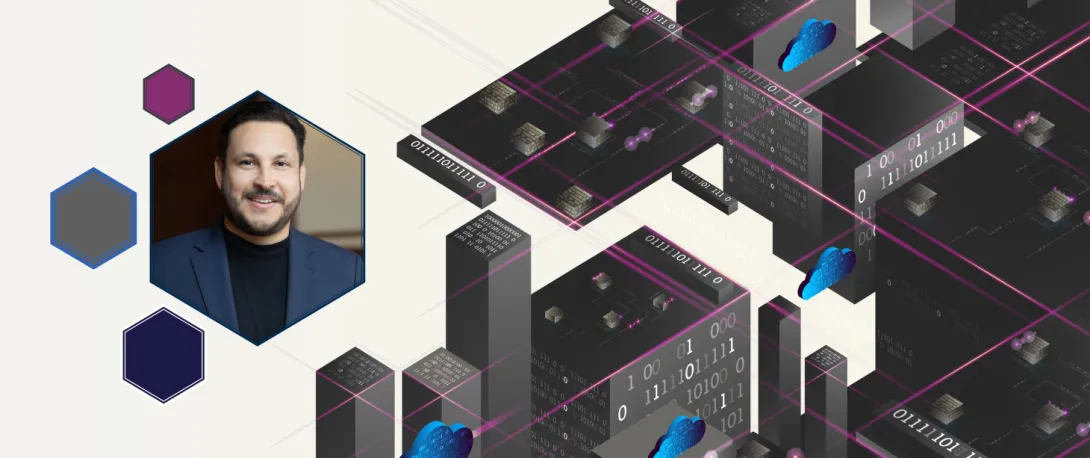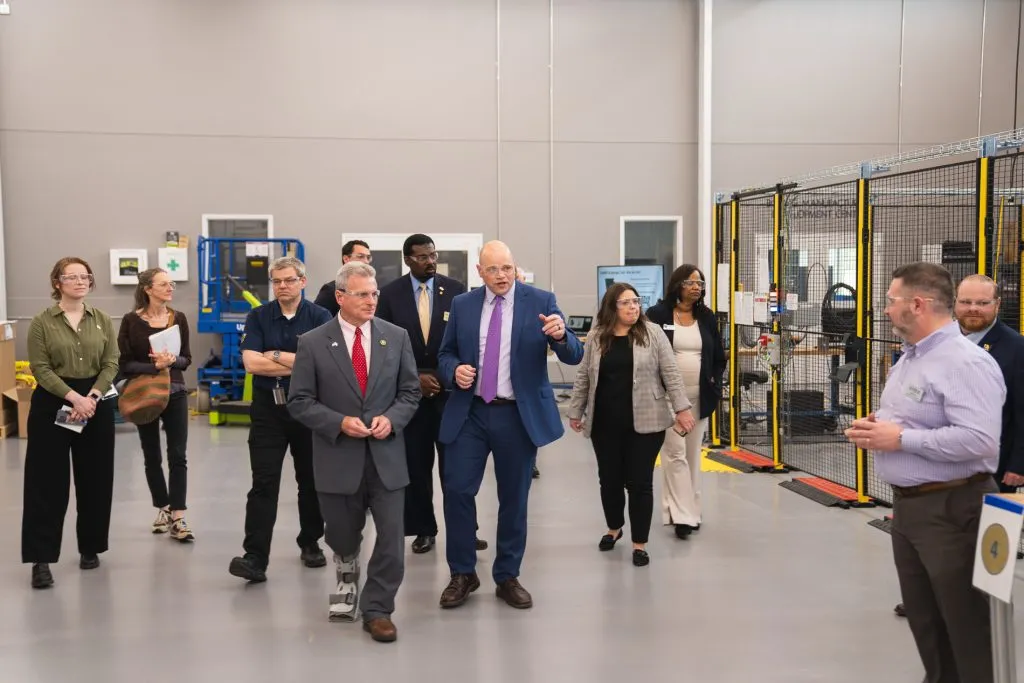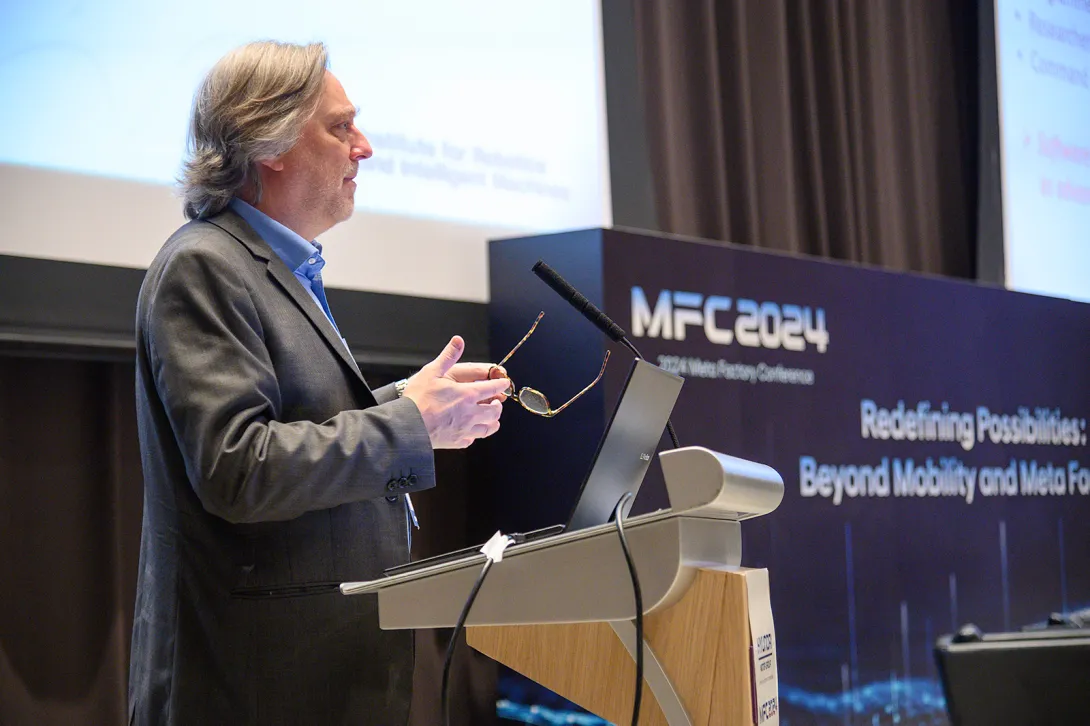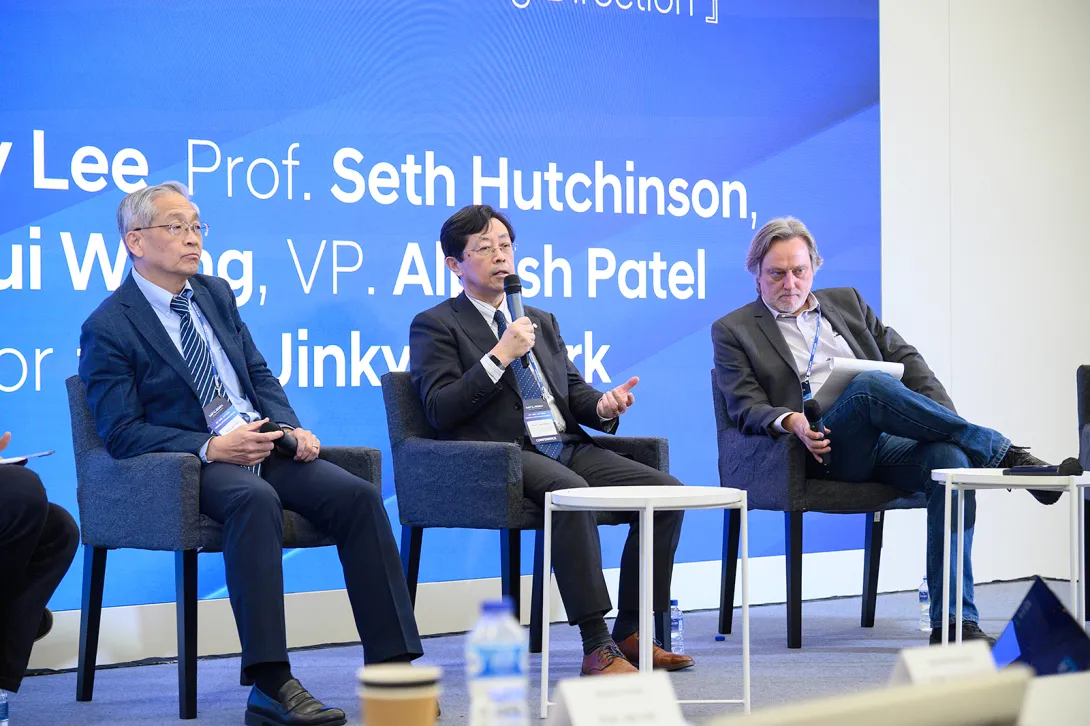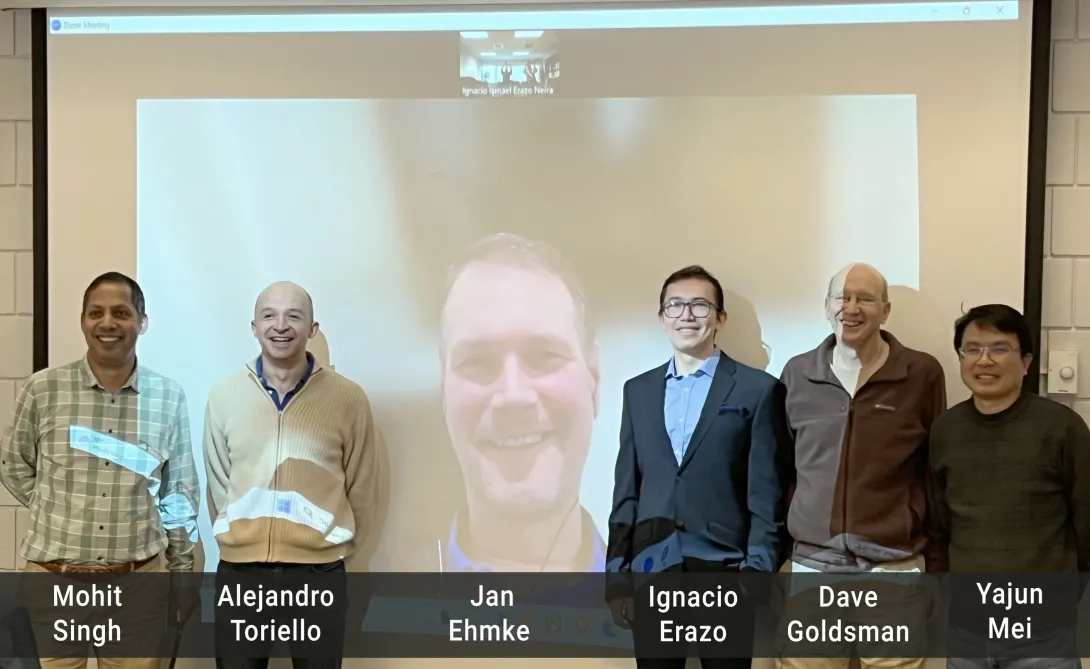May. 03, 2024
With a network of twenty-seven sites across the United States, Americold Logistics, was presented with a critical operational snag that threatened their level of efficiency: disparate labor planning systems.
This inconsistency meant potential bottlenecking and inefficiencies across the supply chain.
Enter in Senior Design team, The Americoldest, and their project “Tracking & Allocation Redesign,” who was selected as the Best of ISyE Team at the 2024 Capstone Design Expo.
Armed with their technical prowess and problem-solving acumen, they set their sights on streamlining labor planning across sites, optimizing resource allocation and maximizing productivity.
“Our solution was to design a sophisticated model that monitors historical data alongside real-time labor metrics, subsequently channeled into an optimization algorithm. This algorithm minimizes labor hours per shift, empowering the organization to execute data-informed decision-making,” stated undergraduate student, Landon Ledford.
Guided by their client sponsor Will Byrd and faculty advisor Dr. Xin Chen, this project is being deployed across all sites and implemented internationally starting with Dublin, Ireland.
Team Name: The Americoldest
Project Title: Tracking & Allocation Redesign
Team Members:
Rohan Bagade
Landen Ledford
Curran Myers
Chandler Pittman
Justin Siegel
Alex Sowatzka
Nicholas Van
Sloan Wilds
Collectively, they were awarded $1,500 and bragging rights as the best ISyE team for the spring semester.
Out of 204 teams from various schools and colleges across Georgia Tech, 24 teams comprised of 177 students represented the H. Milton Stewart School of Industrial and Systems Engineering (ISyE) during the 2024 Capstone Design Expo.
Capstone Design Expo at Georgia Tech is the ultimate test for undergraduate students.
Working in teams, they learn the ins-and-outs of engineering design, from ideation to solutions.
They tackle real-world challenges proposed by industry leaders or pursue their own entrepreneurial ventures to create solutions for unsolved problems.
As Director of Professional Practice, Dr. Dima Nazzal plays a pivotal role in shaping the trajectory of ISyE’s Senior Design course.
Supporting Nazzal in this endeavor is their dedicated Academic Program Manager, Daniela Estrada. Together, they form a dynamic team committed to ensuring that students receive comprehensive support and resources, empowering them to thrive from project inception to execution.
Honorable Mention: Pop-up Spaces
In the US, over 42,000 pop-up businesses struggle to find suitable locations and events, while retail businesses seek to boost foot-traffic and revenue.
Senior Design team, PopUp Spaces, developed a platform aimed at bridging the gap by connecting pop-up businesses with available retail spaces.
Selected for Honorable Mention, PopUp Spaces offers distinct features through popupspaces.io such as foot-traffic measurement and customizable square footage, fostering a symbiotic relationship between the two markets.
Project Title: Pop-up Spaces
Team Members:
Kirti Bharadwaj (IE)
Matthew Kaminsky (IE)
Ayaan Momin (CompE)
Garret Moore (IE)
Bethanie Penna (IE)
Keerthana Thotakura (CS)
Kya Wiggins (IE)
Faculty Advisor: Dr. Xin Chen
Congratulations to all participating teams for their outstanding presentations, showcasing. Each project showcased ingenuity and innovation, offering viable solutions poised to make tangible impacts in the ever-evolving landscape of industrial engineering.
Read more about the expo here.
Apr. 26, 2024
"Engineering solutions should not only solve problems but also address the societal and environmental impacts they create," states Professor Sofia Perez-Guzman, emphasizing the holistic approach to engineering at Georgia Tech.
Perez-Guzman's philosophy underscores her dual roles in the School of Civil and Environmental Engineering (CEE) and the H. Milton Stewart School of Industrial and Systems Engineering(ISyE).
In her roles, she applies her comprehensive academic background to deepen the understanding of engineering’s broader implications, focusing on how these fields impact society and the environment.
Academic Steps in Resilient Engineering
Perez-Guzman's scholarly journey originated in Colombia at the Universidad del Valle, where she earned a Bachelor's degree in Industrial Engineering.
Her academic ambition propelled her to the United States, where she pursued a Master's degree in Transportation Engineering and a Master’s degree in Economics at Rensselaer Polytechnic Institute (RPI).
During her Master's studies, she engaged in research focused on the economics of freight transportation and its role in food deserts. She developed an analytical model to understand the formation of areas underserved by food supply chains.
Perez-Guzman's educational achievements culminated in a Ph.D. in Transportation Engineering from RPI in December 2022.
Her doctoral thesis centered on the realm of disaster response logistics, where she created humanitarian (beneficiary-oriented) analytical models for the distribution of relief goods in post-disaster scenarios.
Emphasizing her unwavering commitment to enhancing the robustness and sustainability of supply chains, Perez-Guzman aims to bridge the divide between traditional responses and visionary foresight.
Research and Teaching Pedagogy
Her current research explores the societal impact of supply chains, specifically through the lens of freight transportation.
This work seeks to develop decision-making support tools that address complex societal challenges where freight transportation plays a crucial role in either contributing to societal issues or helps in facilitating solutions.
In the classroom, Perez-Guzman translates these complex research themes into digestible, actionable lessons. She is currently instructing an undergraduate course dedicated to Multimodal Transportation and is set to introduce a new graduate course on Freight Transportation in the Spring semester.
"Our focus must be on developing research that is not only theoretically robust but also practical and implementable for those deploying these solutions in real-world scenarios. By understanding the needs of end-users and delivering tools that practitioners can readily employ, we move one step closer to making a tangible impact on the field."
Transitioning from theory to practice, she envisions her students as future leaders who’ll prioritize long-term sustainability and resilience in their professional endeavors, contributing to the creation of smarter, more adaptable transportation systems and supply chains systems globally.
Molding Holistic Supply Chain Leaders
Amidst these advanced theoretical and practical frameworks, Perez-Guzman encourages her students to further personalize their educational journey.
For students aiming to propel their career in Supply Chain management, Perez-Guzman encourages students to specialize and excel in a specific interest area.
"Dive deeper into your studies and seek out academic challenges beyond the syllabus. Engaging in competitions and embracing every learning opportunity your institution offers can equip you with a distinctive advantage. Remember, the aim is to distinguish yourself with specialized knowledge or skills.”
Additionally, Perez-Guzman emphasized a crucial blend of technical prowess and soft skills for students venturing into supply chain management.
"Georgia Tech students boast exceptional technical skills, a point that's well acknowledged. However, there's an increasing need for them to also focus on developing their soft skills, like communication, both oral and written. Modern companies seek more than just outstanding coders or data scientists; they require professionals who can translate complex theories, algorithms, and results into digestible content which is essential for decision-making. Therefore, it's crucial for our students to develop these soft skills to fully meet the interdisciplinary needs of the future."
Author: Atharva Anand Dave
Apr. 12, 2024
On April 12, 2024, Georgia Tech's Supply Chain and Logistics Institute (SCL) hosted a productive meeting of its Industry Advisory Board (IAB), bringing together key stakeholders from industry and academia to shape the future of supply chain education and research. The agenda commenced with a pre-meeting social, fostering networking opportunities among IAB members, faculty, and industry guests. Following a welcome by Professor Benoit Montreuil (SCL Executive Director), the SCL leadership team provided updates on the institute's progress and addressed common questions, setting the stage for dynamic discussions.
Representatives from leading companies joined the meeting, reflecting the broad industry interest in shaping the future of supply chain education and research. Attending companies included: Amazon, Americold, Cisco, Coca-Cola, Dematic, Georgia Center of Innovation in Logistics, Graphic Packaging International, The Home Depot, Georgia Ports Authority, Hartsfield-Jackson Atlanta International Airport, Michelin North America, MiTek, Newell Brands, Steelcase, UPS.
Professors Frederick Benaben and Chris Gaffney (SCL Managing Director) led a session on professional and lifelong supply chain education, seeking input on future strategies. Participants, including representatives from The Home Depot and Steelcase, emphasized the importance of practical application and cohesive program structures to maximize learning outcomes. This emphasis resonates with SCL's mission to bridge the gap between academia and industry, ensuring that educational offerings are not only rigorous but also relevant and applicable to real-world scenarios.
Infrastructure and logistics at a societal level took center stage, with discussions ranging from state-level initiatives in Georgia to novel ideas under ARPA-I. By exploring state-level initiatives, such as responses to the GA Senate Infrastructure Ask and collaborations with organizations like the Georgia Center of Innovation and the Atlanta Regional Commission, participants delved into how strategic partnerships and policy decisions can drive positive outcomes at scale.
Professor Alejandro Toriello (SCL Scientific Director) provided insights into ongoing research efforts, followed by faculty spotlights on AI and machine learning by Assistant Professor Tuo Zhao, shedding light on breakthroughs in natural language AI. Research students Dipayan Banerjee (Topic: Tactical Planning for Same-Day Delivery) and Lacy Greening (Topic: E-Commerce Fulfillment Network Planning) gave excellent presentations on innovative approaches to last-mile delivery and e-commerce network design, respectively, garnering interest from practitioners in attendance.
Chris Gaffney led discussions on the future of partnerships, seeking input on enhancing collaboration between academia and industry. Attendees emphasized the need for deeper engagement and a clearer understanding of the institute's capabilities. White space discussions highlighted areas for further exploration, including cybersecurity, sustainability, and diversity in the supply chain space. Attendee feedback underscored the importance of diverse perspectives and thought leadership in driving innovation.
The meeting concluded with plans for future engagement and reaffirming Georgia Tech's commitment to serving as a catalyst for industry advancements.
Apr. 16, 2024
On Tuesday, April 16th, Georgia Tech Supply Chain and Logistics Institute (SCL) Managing Director Chris Gaffney joined SVP Stephanie Smith and Director Gonzalo Cordova from The Home Depot along with Emilie Schario, Founder and CEO of Turbine, and Georgia Tech Advanced Technology Development Center (ATDC) Supply Chain Catalyst Alex Rhodeen for a dynamic panel discussion on the state of Supply Chain, the role of AI, and where we're headed next. As part of the discussion, the panel addressed issues on globalization, geopolitical tensions, sustainability concerns, and the impact of natural disasters on supply chains. The panelists also provided examples of how AI technologies such as machine learning, predictive analytics, and robotic process automation are being used to optimize various aspects of the supply chain, from demand forecasting to inventory management to logistics. The group stressed the role of AI and how it will be pivotal in shaping the future of supply chain management through fostering agility, sustainability, and competitive advantage. In addition to the panel, more than 20 ATDC companies participated in a showcase to present their solutions to the Georgia Tech startup ecosystem.
This event was part of ATDC's Supply Chain vertical, generously supported by The Home Depot. As a key component of this collaboration, Home Depot executives mentor program participants and offer guidance and expertise as they build, test, and bring new products and services to market. The initiative aims to drive innovation and nurture the growth of startups in the supply chain and logistics sector, leveraging the robust expertise and infrastructure available in Georgia. Given the evolving landscape of supply chain and logistics, partnerships with program participants are increasingly vital for early-stage companies, facilitating customer acquisition and business model development. The Supply Chain vertical is the sixth of its kind at ATDC, a globally recognized technology incubator, and follows other targeted programs in health, retail, and financial technologies. Through collaboration with SCL, ATDC fosters the innovation of Georgia-grown supply chain solutions.
ABOUT ATDC
The Advanced Technology Development Center (ATDC), a program of the Georgia Institute of Technology, is the state of Georgia’s technology startup incubator. Founded in 1980 by the Georgia General Assembly which funds it each year, ATDC’s mission is to work with entrepreneurs in Georgia to help them learn, launch, scale, and succeed in the creation of viable, disruptive technology companies. Since its founding, ATDC has grown to become the longest running and one of the most successful university-affiliated incubators in the United States, with its graduate startup companies raising $3 billion in investment financing and generating more than $12 billion in revenue in the state of Georgia. ATDC brings a unique framework that combines its startup curriculum, coaching, connections, and community, as well as direct access to Georgia Tech resources, research expertise, and student talent, to help entrepreneurs learn, launch, scale, and succeed. In this effort, ATDC will offer programming, recruit and evaluate startups, and hire staff to manage the vertical. Learn more at atdc.org.
Apr. 22, 2024
With new vehicle models being developed by major brands and a growing supply chain, the electric vehicle (EV) revolution seems well underway. But, as consumer purchases of EVs have slowed, car makers have backtracked on planned EV manufacturing investments. A major roadblock to wider EV adoption remains the lack of a fully realized charging infrastructure. At just under 51,000 public charging stations nationwide, and sizeable gaps between urban and rural areas, this inconsistency is a major driver of buyer hesitance.
How do we understand, at a large scale, ways to make it easier for consumers to have confidence in public infrastructure? That is a major issue holding back electrification for many consumer segments.
- Omar Asensio, Associate Professor at Georgia Institute of Technology and Climate Fellow, Harvard Business School | Director, Data Science & Policy Lab
Omar Asensio, associate professor in the School of Public Policy and director of the Data Science and Policy Lab at the Georgia Institute of Technology, and his team have been working to solve this trust issue using the Microsoft CloudHub partnership resources. Asensio is also currently a visiting fellow with the Institute for the Study of Business in Global Society at the Harvard Business School.
The CloudHub partnership gave the Asensio team access to Microsoft’s Azure OpenAI to sift through vast amounts of data collected from different sources to identify relevant connections. Asensio’s team needed to know if AI could understand purchaser sentiment as negative within a population with an internal lingo outside of the general consumer population. Early results yielded little. The team then used specific example data collected from EV enthusiasts to train the AI for a sentiment classification accuracy that now exceeds that of human experts and data parsed from government-funded surveys.
The use of trained AI promises to expedite industry response to consumer sentiment at a much lower cost than previously possible. “What we’re doing with Azure is a lot more scalable,” Asensio said. “We hit a button, and within five to 10 minutes, we had classified all the U.S. data. Then I had my students look at performance in Europe, with urban and non-urban areas. Most recently, we aggregated evidence of stations across East and Southeast Asia, and we used machine learning to translate the data in 72 detected languages.”
We are excited to see how access to compute and AI models is accelerating research and having an impact on important societal issues. Omar's research sheds new light on the gaps in electric vehicle infrastructure and AI enables them to effectively scale their analysis not only in the U.S. but globally.
- Elizabeth Bruce, Director, Technology for Fundamental Rights, Microsoft
Asensio's pioneering work illustrates the interdisciplinary nature of today’s research environment, from machine learning models predicting problems to assisting in improving EV infrastructure. The team is planning on applying the technique to datasets next, to address access concerns and reduce the number of “charging deserts.” The findings could lead to the creation of policies that help in the adoption of EVs in infrastructure-lacking regions for a true automotive electrification revolution and long-term environmental sustainability in the U.S.
- Christa M. Ernst
Source Paper: Reliability of electric vehicle charging infrastructure: A cross-lingual deep learning approach - ScienceDirect
News Contact
Christa M. Ernst
Research Communications Program Manager
Topic Expertise: Robotics | Data Sciences| Semiconductor Design & Fab
Research @ the Georgia Institute of Technology
christa.ernst@research.gatech.edu
Apr. 19, 2024
The University System of Georgia (USG) Board of Regents honored 12 Georgia Tech faculty members across campus with Regents’ appointments at its April meeting.
Among those recognized is Georgia Tech Manufacturing Institute (GTMI) Executive Director Thomas Kurfess, who was named Regents' Professor. The highest distinction awarded by the USG, Regents' distinctions recognize faculty members for academic, innovation, and entrepreneurial excellence.
About Kurfess
Thomas Kurfess
Regents’ Professor, George W. Woodruff School of Mechanical Engineering
HUSCO/Ramirez Distinguished Chair in Fluid Power and Motion Control
Kurfess researches advanced manufacturing systems, designing, developing, and optimizing new approaches for complex production systems. He helps lead a $65 million effort to use artificial intelligence in manufacturing and transform Georgia’s industrial economy. The Georgia AI Manufacturing (GA-AIM) Technology Corridor is creating and deploying new AI innovations across all manufacturing sectors while training the necessary talent and workforce.
In addition to his role as executive director of GTMI, Kurfess is the 2023-24 president of the American Society of Mechanical Engineers (ASME).
He served as chief manufacturing officer at Oak Ridge National Laboratory from 2019 to 2021, overseeing strategic planning in advanced manufacturing. Kurfess also previously led the advanced manufacturing team at the White House Office of Science and Technology Policy during the Obama administration from 2012 to 2013.
Kurfess is a member of the National Academy of Engineering and a fellow of the Society of Manufacturing Engineers, ASME, and the American Association for the Advancement of Science.
News Contact
Audra Davidson
Research Communications Program Manager
Institute Communications
Apr. 19, 2024
When U.S. Rep. Earl L. “Buddy” Carter from Georgia’s 1st District visited Atlanta recently, one of his top priorities was meeting with the experts at Georgia Tech’s 20,000-square-foot Advanced Manufacturing Pilot Facility (AMPF).
Carter was recently named the House Energy and Commerce Committee’s chair of the Environment, Manufacturing, and Critical Materials Subcommittee, a group that concerns itself primarily with contamination of soil, air, noise, and water, as well as emergency environmental response, whether physical or cybersecurity.
Because AMPF’s focus dovetails with subcommittee interests, the facility was a fitting stop for Carter, who was welcomed for an afternoon tour and series of live demonstrations. Programs within Georgia Tech’s Enterprise Innovation Institute — specifically the Georgia Artificial Intelligence in Manufacturing (Georgia AIM) and Georgia Manufacturing Extension Partnership (GaMEP) — were well represented.
“Innovation is extremely important,” Carter said during his April 1 visit. “In order to handle some of our problems, we’ve got to have adaptation, mitigation, and innovation. I’ve always said that the greatest innovators, the greatest scientists in the world, are right here in the United States. I’m so proud of Georgia Tech and what they do for our state and for our nation.”
Carter’s AMPF visit began with an introduction by Thomas Kurfess, Regents' Professor and HUSCO/Ramirez Distinguished Chair in Fluid Power and Motion Control in the George W. Woodruff School of Mechanical Engineering and executive director of the Georgia Tech Manufacturing Institute; Steven Ferguson, principal research scientist and managing director at Georgia AIM; research engineer Kyle Saleeby; and Donna Ennis, the Enterprise Innovation Institute’s director of community engagement and program development, and co-director of Georgia AIM.
Ennis provided an overview of Georgia AIM, while Ferguson spoke on the Manufacturing 4.0 Consortium and Kurfess detailed the AMPF origin story, before introducing four live demonstrations.
The first of these featured Chuck Easley, Professor of the Practice in the Scheller College of Business, who elaborated on supply chain issues. Afterward, Alan Burl of EPICS: Enhanced Preparation for Intelligent Cybermanufacturing Systems and mechanical engineer Melissa Foley led a brief information session on hybrid turbine blade repair.
Finally, GaMEP project manager Michael Barker expounded on GaMEP’s cybersecurity services, and Deryk Stoops of Central Georgia Technical College detailed the Georgia AIM-sponsored AI robotics training program at the Georgia Veterans Education Career Transition Resource (VECTR) Center, which offers training and assistance to those making the transition from military to civilian life.
The topic of artificial intelligence, in all its subtlety and nuance, was of particular interest to Carter.
“AI is the buzz in Washington, D.C.,” he said. “Whether it be healthcare, energy, [or] science, we on the Energy and Commerce Committee look at it from a sense [that there’s] a very delicate balance, and we understand the responsibility. But we want to try to benefit from this as much as we can.”
“I heard something today I haven’t heard before," Carter continued, "and that is instead of calling it artificial intelligence, we refer to it as ‘augmented intelligence.’ I think that’s a great term, and certainly something I’m going to take back to Washington with me.”
“It was a pleasure to host Rep. Carter for a firsthand look at AMPF," shared Ennis, "which is uniquely positioned to offer businesses the opportunity to collaborate with Georgia Tech researchers and students and to hear about Georgia AIM.
“At Georgia AIM, we’re committed to making the state a leader in artificial intelligence-assisted manufacturing, and we’re grateful for Congressman Carter’s interest and support of our efforts."
News Contact
Eve Tolpa
Senior Writer/Editor
Enterprise Innovation Institute (EI2)
Mar. 04, 2024
Hyundai Motor Group Innovation Center Singapore hosted the Meta-Factory Conference Jan. 23 – 24. It brought together academic leaders, industry experts, and manufacturing companies to discuss technology and the next generation of integrated manufacturing facilities.
Seth Hutchinson, executive director of the Institute for Robotics and Intelligent Machines at Georgia Tech, delivered a keynote lecture on “The Impacts of Today’s Robotics Innovation on the Relationship Between Robots and Their Human Co-Workers in Manufacturing Applications” — an overview of current state-of-the-art robotic technologies and future research trends for developing robotics aimed at interactions with human workers in manufacturing.
In addition to the keynote, Hutchinson also participated in the Hyundai Motor Group's Smart Factory Executive Technology Advisory Committee (E-TAC) panel on comprehensive future manufacturing directions and toured the new Hyundai Meta-Factory to observe how digital-twin technology is being applied in their human-robot collaborative manufacturing environment.
Hutchinson is a professor in the School of Interactive Computing. He received his Ph.D. from Purdue University in 1988, and in 1990 joined the University of Illinois Urbana-Champaign, where he was professor of electrical and computer engineering until 2017 and is currently professor emeritus. He has served on the Hyundai Motor Group's Smart Factory E-TAC since 2022.
Hyundai Motor Group Innovation Center Singapore is Hyundai Motor Group’s open innovation hub to support research and development of human-centered smart manufacturing processes using advanced technologies such as artificial intelligence, the Internet of Things, and robotics.
- Christa M. Ernst
Related Links
- Hyundai Newsroom Article: Link
- Event Link: https://mfc2024.com/
- Keynote Speakers: https://mfc2024.com/keynotes/
News Contact
Christa M. Ernst - Research Communications Program Manager
christa.ernst@research.gatech.edu
Feb. 29, 2024
As we tap into the new year, alumnus Chris Gaffney (BSIE ’85, MSIE ’86) steps into his role as the Managing Director of the Supply Chain and Logistics Institute (SCL) and the Academic Program Director for Georgia Tech Professional Education (GTPE). With expertise in the field, his return to Georgia Tech welcomes fresh methods and inspiration to enhance the program's supply chain operations. Having earned both his degrees from the H. Milton Stewart School of Industrial and Systems Engineering (ISyE), Gaffney's journey intertwines deeply with the institution’s growth and impact.
Gaffney’s Return
"For the most part, I've only lived in two places in my life…growing up in DC and then living in Atlanta, I was very fortunate to choose Georgia Tech for both my bachelor's and master’s in industrial engineering." Throughout the years, Gaffney was involved in the community serving on the ISyE Advisory Board, Supply Chain and Logistics Industry Advisory Board, and the Mentees Program at Georgia Tech. Influenced by the ISyE community, Gaffney aims to reciprocate the school’s impact by leveraging his experiences from the Coca-Cola Company to enhance the program. In his new role, Chris wants to continue driving cross-collaboration with SCL partnerships. “Georgia Tech is on the leading edge of the advancements in supply chain and logistics, so I'm hopeful that part of what we could do more of in SCL is help companies access more of that, faster.” Additionally, Gaffney believes there’s an increasing urgency to advancing and “bringing people the type of learning in a way that they can grow their own professional capabilities [and become more multidisciplinary].”
Leadership in Logistics
Gaffney's professional journey began at Frito-Lay, where he navigated operational intricacies as a logistics analyst, later advancing to operations manager. Subsequently, he honed his expertise in international logistics and strategic supply chain management at AJC International and the Coca-Cola Company. Gaffney's tenure at Coca-Cola, spanning over two decades as the Director of National Distribution, and then VP of Transportation for US Coke, epitomizes his commitment to collaboration and innovation. "Coca-Cola taught me the importance of understanding how collaboration works within large enterprises and across companies." Internally, he also served in positions as President of Coca-Cola Supply, and as the President of the National Product Supplied Group, for the US Bottlers. For Gaffney, the journey wasn't just about personal success but about paving pathways for others, bridging the gap in the field between inspiration and accessibility.
Accessibility Through Collaboration
“-- A big part for me is this idea of, how do you bring the promise of the digital age of supply chain and make it accessible to more and more companies and people?” With the benefit of staying local, Gaffney supported driving academic, and corporate impact through collaboration – specifically towards initiatives aimed at increasing student co-ops, and full-time employment opportunities between Georgia Tech and the Coca-Cola Company. With mentorship serving as a cornerstone in Gaffney’s professional landscape, he believes in advocating for the transformative power of supportive relationships. “[My mentor] would make sure I was on track…it was a much smaller situation then, but it made a huge difference for me, and I never forgot about that -- I've had some really critical mentors early in my career, so I'm a big believer in mentoring and coaching.”
Yellow Jacket Trajectory
Gaffney’s ties to Georgia Tech, spanning decades of investment, characterize a lifelong commitment to growth and service. The motivation and influence instilled during his time at Tech transferred to his life in more ways than one. Chris met his wife at Georgia Tech and has been married for over 30 years; with four adult children, including one being a GT graduate in the field of Supply Chain. Even in hardship, Gaffney’s family is passionate about doing all they can, including relentlessly supporting one of their own as a childhood cancer survivor. They’re also heavily involved philanthropically, specifically in raising money for research on childhood cancer, “we believe that we have a responsibility to do what we can.” As Gaffney shared his final thoughts, he leaves us with a hopeful view, channeled in the moments where he started the beginnings of his career – back on Georgia Tech campus.
News Contact
info@scl.gatech.edu
Feb. 28, 2024
Ignacio Erazo recently defended his thesis titled "Efficient Two-Sample Bernoulli Confidence Intervals and Submodular Dispatching", earning his PhD in Operations Research with a minor in Machine Learning under the supervision of Professors David Goldsman and Alejandro Toriello. Erazo's research interests involve the development of efficient optimization algorithms and heuristics for intelligent decision-making as well as large-scale simulation-optimization procedures. Collaborating with Professor Goldsman, he worked on the efficient computation of Confidence Intervals (CIs) for the difference of probabilities between two populations, with applications in health care, last-mile distribution, and production scheduling. This work is useful for many practical problems such as testing new drugs, evaluating inventory policies, estimating contamination rates, or evaluating the difference in rate of adverse events between generic and brand-name drugs. What is notable about his approach is that it uses fewer observations and generates lower costs. With Professor Toriello, Ignacio focused on problems where orders or items arrive at different times and must be processed or delivered in batches (e.g., e-commerce, machine scheduling). By using mathematical models and proposing new algorithms, the team studied the fundamental trade-offs between waiting for orders and batching them, such as obtaining economies of scale, versus the idleness of resources generated by that strategy. This problem has multiple applications in same-day delivery, machine scheduling, and production environments. This work has been presented at scholarly seminars, at multiple INFORMS Annual Meetings, and at the Transportation Science and Logistics (TSL) Conference. Notably, Ignacio's work was recognized with the Best Applied Student Paper Award at Winter Simulation Conference in 2022.
Prior to his doctoral studies at Georgia Tech, Ignacio obtained his degree in industrial civil engineering from the University of Concepcion in 2019. From a very young age, he loved doing math to solve problems and enjoyed participating in math competitions. "Without even recognizing it, I would obsess over taking the 'best' or optimal approach for everything I could. When I took my first optimization class it was obvious to me that this subset of extremely applied math (optimization, but in a broader sense Operations Research) was what I wanted to do in the future, and possibly forever. Essentially, at that point I already knew I wanted to deepen my knowledge, which meant the best course of action was to do a PhD in a university with the best professors." Reflecting on his journey, Ignacio shares his admiration for Georgia Tech's leading position in Operations Research, highlighting the wealth of expertise available within the department. "While Georgia Tech is not as known as other schools in the rest of the world (i.e., Stanford, Harvard, MIT), Georgia Tech leads almost every ranking related to OR. The department is extremely large and there is a professor working in almost every topic. Specific to optimization, logistics, and supply chain, we have a very large number of researchers and professors. That is the reason why GT was one of the only four places I applied to. Knowing what I know today, GT would be second to none."
Erazo’s professional experience includes internships as an applied and research scientist at tech giants Amazon and Apple where he contributed to cutting-edge projects in supply chain management and inventory optimization. At Apple, he was part of the team that develops science-based solutions for its supply chain. In particular, he worked on inventory management for Apple Stores and on "real-time" carrier selection for Apple's supply chain. His projects involved building new methodologies to solve those problems and coding prototypes that could serve as a starting point for deployment and production.
Recently, Erazo joined Amazon Fulfillment Technologies & Robotics as a Research Scientist II. Amazon operates an extensive and intricate supply chain that constantly advances by integrating robotic tools to boost warehouse efficiency. Within this dynamic framework, the algorithmic tools that enable its warehouses to work at their best need to be continuously modified, improved, and enhanced with new capabilities and use cases. Ignacio will meet the challenge by helping create, pilot, and seamlessly deploy new performance and safety-driven algorithms for Amazon's robotic-assisted picking warehouses across its entire network.
Ignacio's dedication to problem-solving and his passion for optimization exemplify the spirit of inquiry and innovation that defines our academic community. We congratulate him on this achievement and look forward to witnessing his continued contributions to the field.
News Contact
info@scl.gatech.edu
Pagination
- Previous page
- 8 Page 8
- Next page
